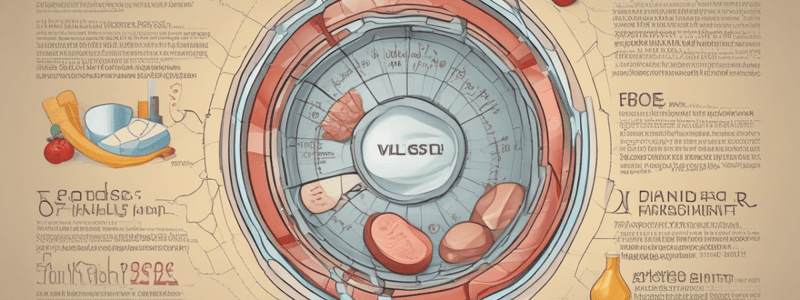Podcast
Questions and Answers
What is the relationship between age and cholesterol levels?
What is the relationship between age and cholesterol levels?
- Cholesterol levels fluctuate with age
- Cholesterol levels decrease with age
- Cholesterol levels increase with age (correct)
- Cholesterol levels remain the same with age
Who tends to have lower cholesterol levels?
Who tends to have lower cholesterol levels?
- Men
- Children
- Women (correct)
- Elderly people
What is the effect of cold periods on cholesterol levels?
What is the effect of cold periods on cholesterol levels?
- Cholesterol levels slightly increase (correct)
- Cholesterol levels remain the same
- Cholesterol levels significantly increase
- Cholesterol levels decrease
What is the effect of daily fat intake on cholesterol levels?
What is the effect of daily fat intake on cholesterol levels?
What is the recommended diet for patients before testing their cholesterol levels?
What is the recommended diet for patients before testing their cholesterol levels?
After how long should lipoprotein measurements be made after an acute illness or infection?
After how long should lipoprotein measurements be made after an acute illness or infection?
What is a lifestyle factor that can contribute to higher lipoprotein levels?
What is a lifestyle factor that can contribute to higher lipoprotein levels?
What happens to cholesterol levels after prolonged venous occlusion?
What happens to cholesterol levels after prolonged venous occlusion?
How long after childbirth should lipoprotein measurements be made?
How long after childbirth should lipoprotein measurements be made?
What is not a part of cholesterol measurement?
What is not a part of cholesterol measurement?
What reactants are used in the Liebermann-Burchardt Reaction?
What reactants are used in the Liebermann-Burchardt Reaction?
What is the first step in the Abell-Kendall method for cholesterol measurement?
What is the first step in the Abell-Kendall method for cholesterol measurement?
What is the purpose of using petroleum jelly in the Abell-Kendall method?
What is the purpose of using petroleum jelly in the Abell-Kendall method?
What is the result of the Liebermann-Burchardt Reaction?
What is the result of the Liebermann-Burchardt Reaction?
How many steps are involved in the Abell-Kendall method for cholesterol measurement?
How many steps are involved in the Abell-Kendall method for cholesterol measurement?
What is the principle used in Bloors Method for cholesterol extraction?
What is the principle used in Bloors Method for cholesterol extraction?
What is the measurement method that specifically detects cholesterol and does not detect sterols?
What is the measurement method that specifically detects cholesterol and does not detect sterols?
What is the gold standard method for cholesterol measurement?
What is the gold standard method for cholesterol measurement?
What is the reference method used for cholesterol measurement?
What is the reference method used for cholesterol measurement?
What is the third method of cholesterol measurement mentioned?
What is the third method of cholesterol measurement mentioned?
What is the purpose of zeolite absorption in the non-enzymatic method?
What is the purpose of zeolite absorption in the non-enzymatic method?
What is the 'double-cuvette blank' correction method used for?
What is the 'double-cuvette blank' correction method used for?
What is the purpose of the 'single-cuvette blank' correction method?
What is the purpose of the 'single-cuvette blank' correction method?
What is the purpose of designated calibration blanking?
What is the purpose of designated calibration blanking?
What is the first step in the non-enzymatic method?
What is the first step in the non-enzymatic method?
What is necessary for the precipitation of lipoproteins with polyanions?
What is necessary for the precipitation of lipoproteins with polyanions?
What is the conversion factor for triglyceride measurement?
What is the conversion factor for triglyceride measurement?
What is the reference level for triglyceride measurement?
What is the reference level for triglyceride measurement?
What type of compounds are used to precipitate lipoproteins?
What type of compounds are used to precipitate lipoproteins?
What is the unit of measurement for triglyceride levels?
What is the unit of measurement for triglyceride levels?
What is the primary purpose of lipoprotein electrophoresis?
What is the primary purpose of lipoprotein electrophoresis?
What type of gel is used in lipoprotein electrophoresis?
What type of gel is used in lipoprotein electrophoresis?
When is lipoprotein electrophoresis indicated?
When is lipoprotein electrophoresis indicated?
What is the limitation of lipoprotein electrophoresis?
What is the limitation of lipoprotein electrophoresis?
What is the benefit of lipoprotein electrophoresis?
What is the benefit of lipoprotein electrophoresis?
What is the purpose of sequential density adjustments of serum in preparative ultracentrifugation?
What is the purpose of sequential density adjustments of serum in preparative ultracentrifugation?
What is a limitation of preparative ultracentrifugation?
What is a limitation of preparative ultracentrifugation?
What permits the fractionation of several or all classes of lipoproteins in a single run?
What permits the fractionation of several or all classes of lipoproteins in a single run?
What is the application of preparative ultracentrifugation?
What is the application of preparative ultracentrifugation?
What type of centrifugation is used to fractionate lipoproteins?
What type of centrifugation is used to fractionate lipoproteins?
What type of methods uses antibody-coated plates for specific epitopes on apolipoproteins?
What type of methods uses antibody-coated plates for specific epitopes on apolipoproteins?
What type of methods are commonly used for measuring cholesterol levels in routine and research labs?
What type of methods are commonly used for measuring cholesterol levels in routine and research labs?
What is used to remove all lipoproteins except HDL in precipitation method?
What is used to remove all lipoproteins except HDL in precipitation method?
What is the purpose of magnetic particles in magnetic method?
What is the purpose of magnetic particles in magnetic method?
What is used to quantitate HDL-C in precipitation method?
What is used to quantitate HDL-C in precipitation method?
What is the advantage of magnetic method over precipitation method?
What is the advantage of magnetic method over precipitation method?
What is the purpose of divalent cations in precipitation method?
What is the purpose of divalent cations in precipitation method?
What is the purpose of the first reagent in the HomogenousMethod Direct HDL-C Assay?
What is the purpose of the first reagent in the HomogenousMethod Direct HDL-C Assay?
What is modified in the HomogenousMethod Direct HDL-C Assay to make them selective for HDL-C?
What is modified in the HomogenousMethod Direct HDL-C Assay to make them selective for HDL-C?
What is the limitation of the HomogenousMethod Direct HDL-C Assay?
What is the limitation of the HomogenousMethod Direct HDL-C Assay?
What is used to consume cholesterol from non-HDL species in the HomogenousMethod Direct HDL-C Assay?
What is used to consume cholesterol from non-HDL species in the HomogenousMethod Direct HDL-C Assay?
What is a characteristic of the HomogenousMethod Direct HDL-C Assay?
What is a characteristic of the HomogenousMethod Direct HDL-C Assay?
Flashcards are hidden until you start studying
Study Notes
Factors Affecting Cholesterol Levels
- Age is directly proportional to cholesterol levels, meaning that cholesterol levels increase with age.
- Sex plays a role in cholesterol levels, with women generally having lower levels than men, except during childhood and early 50s.
- Cholesterol levels are slightly higher during cold seasons or periods.
- Daily intake of fat has a direct impact on cholesterol levels, with increased fat consumption leading to higher cholesterol levels.
- When measuring cholesterol levels, patients should maintain their usual diet for at least 2 weeks and avoid significant weight gain or loss.
Acute Illness and Lipoproteins Measurement
- Measurements of lipoproteins should be delayed for at least 8 weeks after any form of trauma or acute bacterial/viral infection.
- It is recommended to wait for 3-4 months after childbirth to take lipoproteins measurements.
Lifestyle Factors and Lipoproteins
- A sedentary lifestyle is associated with higher lipoproteins levels.
- Poor diet habits contribute to increased lipoproteins levels.
Venous Occlusion and Cholesterol
- Prolonged venous occlusion leads to an increase in cholesterol levels by 10-15%.
Cholesterol Measurement
- Non-enzymatic method uses the Abell-Kendall or Bloors method
Methods
- Liebermann-Burchardt (L-B) Reaction is used to measure cholesterol
- L-B Reaction involves the use of H2SO4, acetic acids, and acetic anhydride to produce a green solution
Abell-Kendall Method
- A 3-step principle
- Step 1: Cholesterol is hydrolyzed with alcoholic KOH
- Step 2: Unesterified cholesterol is extracted with petroleum jelly
- Step 3: Measured using the L-B Reaction
Cholesterol Extraction and Measurement Methods
- There are four methods to extract and measure cholesterol: Bloors Method, 2 Step Principle, Enzymatic Method, and Reference Method.
- Bloors Method involves extracting cholesterol using an alcohol-ether mixture.
- The 2 Step Principle measures cholesterol using the L-B reaction.
- The Enzymatic Method uses cholesterol oxidase to measure cholesterol.
- The Reference Method, also known as GCMS, specifically measures cholesterol and does not detect sterols.
- The Gold Standard Method, used by NIST, is the definitive method for measuring cholesterol using isotope dilution mass spectrometry.
- Isotope dilution mass spectrometry is a highly accurate method for measuring cholesterol, making it the gold standard.
Non-Enzymatic Method for Lipid Extraction
- Lipids are extracted using chloroform.
- Phospholipids are removed by zeolite absorption.
Correction Methods for Endogenous Free Glycerol
- "Double-cuvette blank" method: subtracts glycerol blank measurement without lipase enzyme from total glycerol measurement with complete reagent.
- "Single-cuvette blank" method: measures only endogenous free glycerol by incubating lipase-free reagent, taking a blank reading, adding lipase, incubating, and then taking a final reading to correct for the blank.
- Designated calibration blanking: adjusts calibration set points to net or blank-corrected values to compensate for the average free glycerol content of specimens.
Triglyceride Measurement
- Reference level for triglyceride measurement is less than 176 mg/dL or less than 2.0 mmol/L
- Conversion factor for triglyceride measurement is 0.011
Lipoprotein Precipitation
- Polyanions such as heparin sulfate, dextran sulfate, and phosphotungstate are used to precipitate lipoproteins
- Presence of divalent cations Mg, Ca, and Mn is required for the reaction
Lipoprotein Electrophoresis
- Used to identify rare familial disorders related to lipoproteins
- Indicated when serum triglyceride (TG) levels are greater than 300mg/dL
- Also indicated when fasting serum is lipemic (cloudy or turbid) or when there is significant hyperglycemia (high blood sugar)
- Provides a visual display in detecting unusual or variant patterns of lipoproteins
- Utilizes agarose gel or Polyacrylamide Gel Electrophoresis (PAGE) as the medium for electrophoresis
- Not desirable for precise quantitation, but useful in qualitative analysis
Ultracentrifugation
- Used for preparative purposes to fractionate lipoprotein classes
- Involves sequential density adjustments of serum to separate major and minor lipoprotein classes
- Density-gradient methods can be used in two ways: non-equilibrium and equilibrium
- Density-gradient methods allow for the fractionation of multiple or all lipoprotein classes in a single run
- Methods are useful for quantitative purposes and preparative isolations
- However, the process is tedious, expensive, and technically demanding
HDL-C Estimation Methods
- Precipitation method uses divalent cations and polyanions as precipitation reagents to remove all lipoproteins except HDL, allowing for HDL-C estimation
- Enzymatic method is used to quantitate HDL-C in conjunction with precipitation method
- Magnetic method uses a precipitant complexed to magnetic particles to precipitate HDL-C, which then sediments without requiring centrifugation
Homogenous Method (Direct HDL-C Assay)
- The first reagent in the homogenous method "blocks" non-HDLs using antibodies, polymers, or complexing agents like Cyclodextrin.
- The cholesterol esterase and oxidase enzymes are modified to make them selective for HDL-C.
- A blanking step is used to selectively consume cholesterol from non-HDL species.
- The second reagent measures the accessible HDL-C quantities.
- The homogenous method is highly precise and reasonably accurate.
- However, it lacks specificity for HDL in unusual specimens, such as those with liver and kidney disease.
- The homogenous method does not require pre-treatment of the sample.
Studying That Suits You
Use AI to generate personalized quizzes and flashcards to suit your learning preferences.




